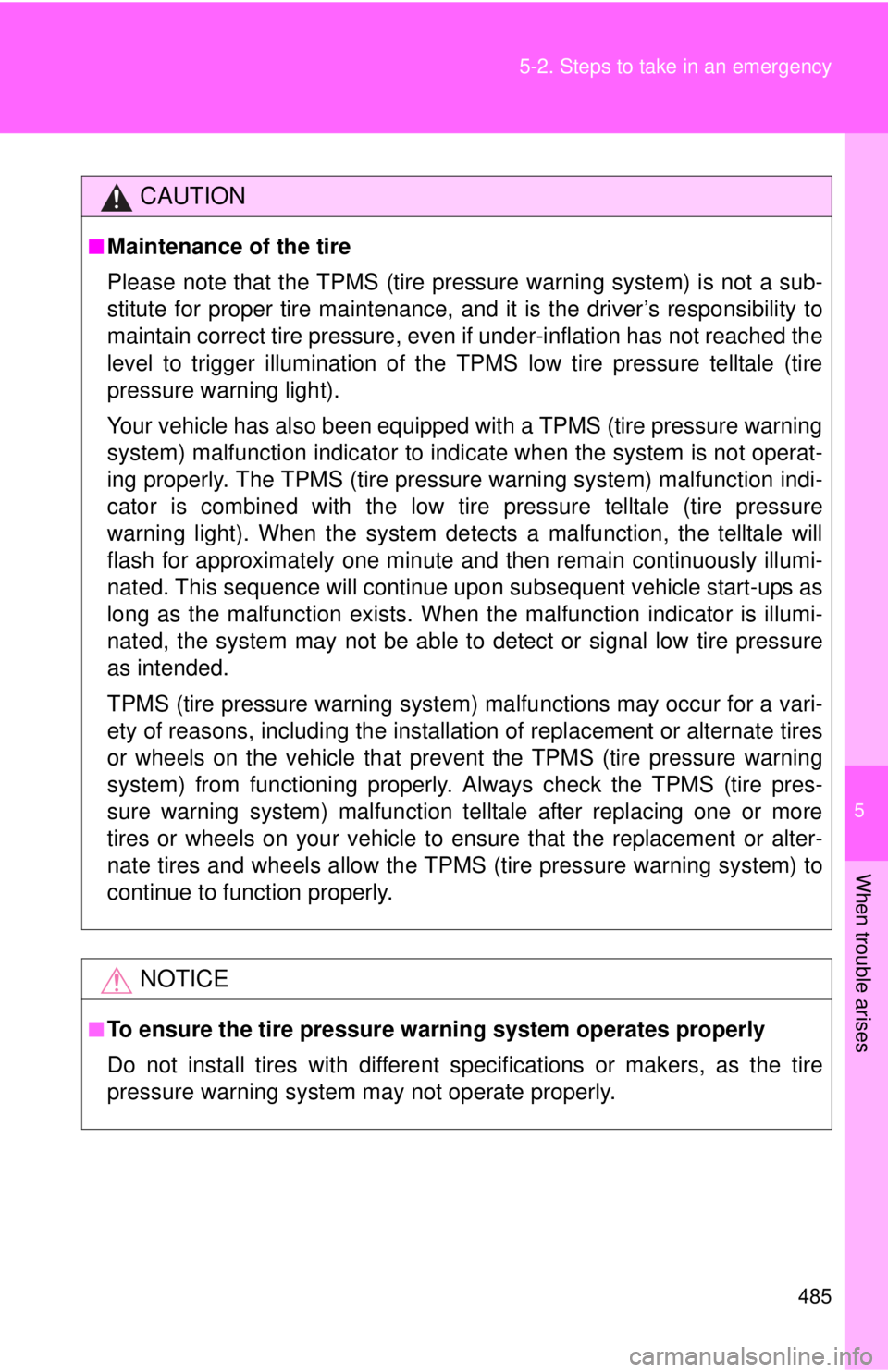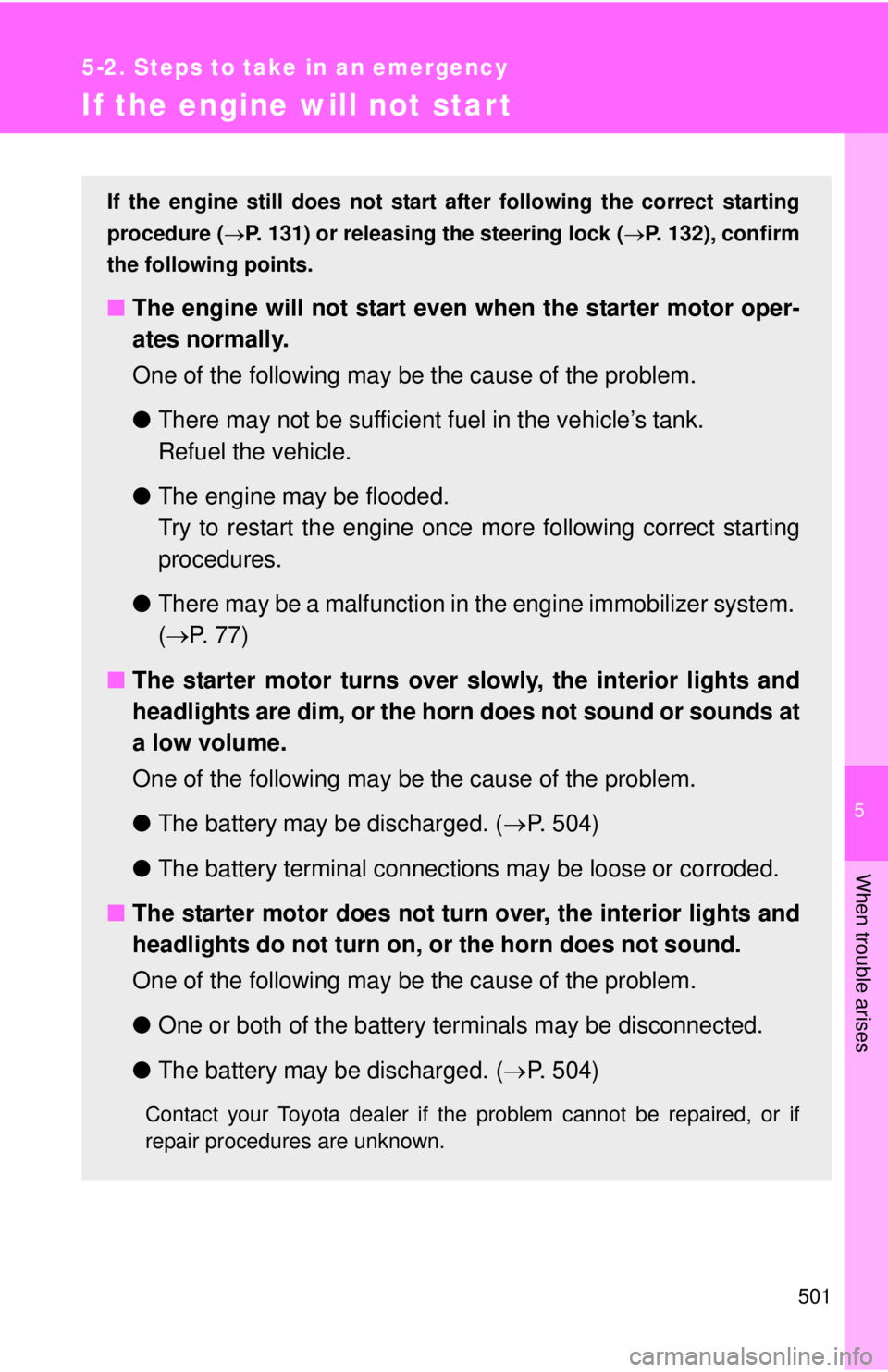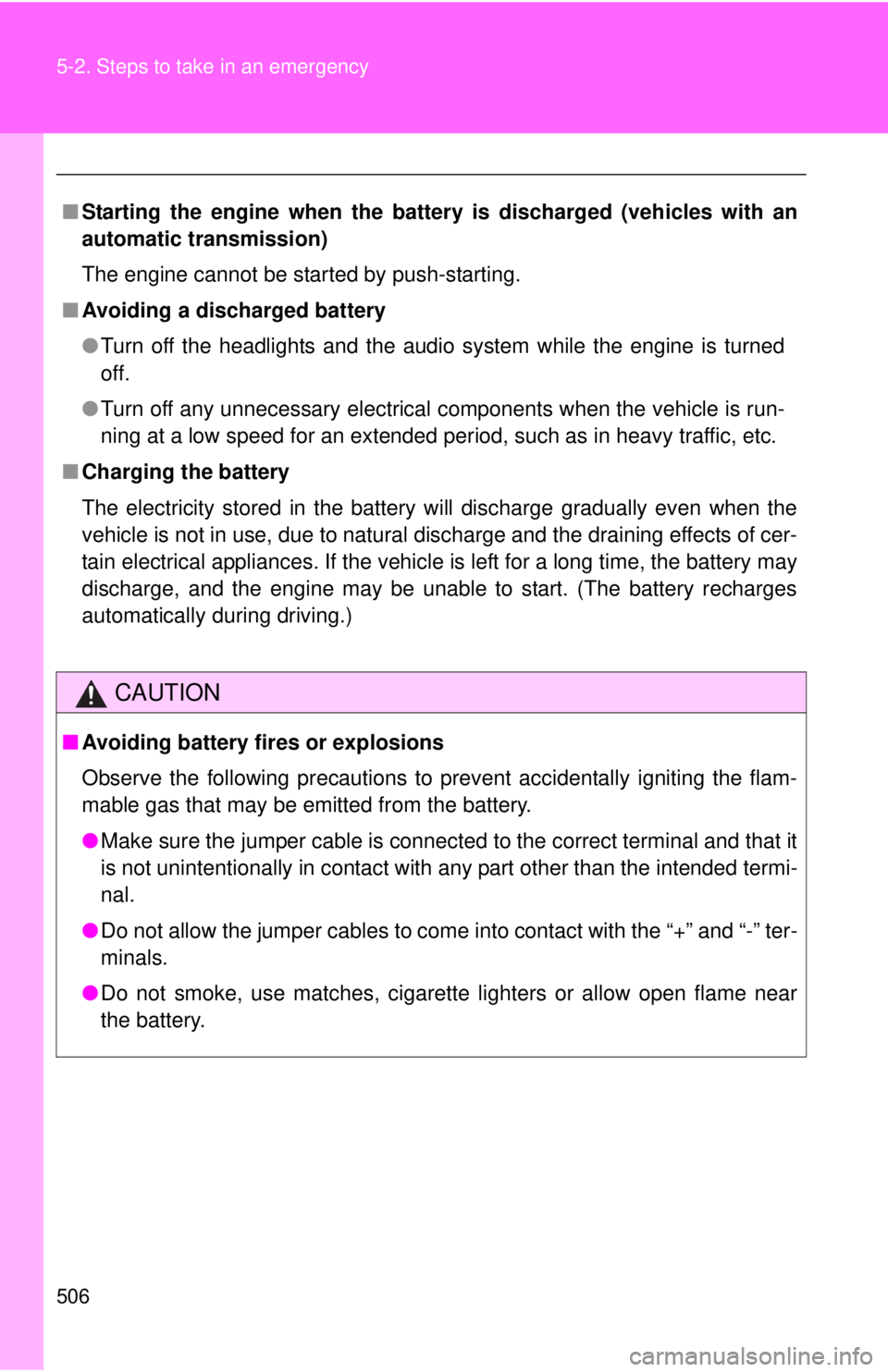Page 485 of 590

5
When trouble arises
485
5-2. Steps to take in an emergency
CAUTION
■Maintenance of the tire
Please note that the TPMS (tire pressure warning system) is not a sub-
stitute for proper tire ma
intenance, and it is the driver’s responsibility to
maintain correct tire pressure, even if under-inflation has not reached the
level to trigger illu mination of the TPMS low ti re pressure telltale (tire
pressure warning light).
Your vehicle has also been equipped with a TPMS (tire pressure warning
system) malfunction indicator to indi cate when the system is not operat-
ing properly. The TPMS (tire pressure warning system) malfunction indi-
cator is combined with the low tire pressure telltale (tire pressure
warning light). When the system det ects a malfunction, the telltale will
flash for approximately one minute an d then remain continuously illumi-
nated. This sequence will continue upon subsequent vehicle start-ups as
long as the malfunction exists. When the malfunction indi cator is illumi-
nated, the system may not be able to detect or signal low tire pressure
as intended.
TPMS (tire pressure warning system) malfunctions may occur for a vari-
ety of reasons, including the installati on of replacement or alternate tires
or wheels on the vehicle that prevent the TPMS (tire pressure warning
system) from functioning properly. Always check the TPMS (tire pres-
sure warning system) malfunction te lltale after replacing one or more
tires or wheels on your vehicle to ensure that the replacement or alter-
nate tires and wheels allow the TPMS (tire pressure warning system) to
continue to function properly.
NOTICE
■To ensure the tire pressure warning system operates properly
Do not install tires with different s pecifications or makers, as the tire
pressure warning system may not operate properly.
Page 492 of 590
492 5-2. Steps to take in an emergency
Slightly loosen the wheel nuts
(one turn).
Assemble the jack handle exten-
sion as shown.
Position the jack at the correct
jack point as shown.Front
Rear
Make sure the jack is positioned
on a level and solid place.
Raise the vehicle until the tire is
slightly raised off the ground.
When positioning the jack under
the rear axle housing, make
sure the groove on the top of
the jack fits with the rear axle
housing.
Front
Page 496 of 590
496 5-2. Steps to take in an emergency
4WD models only: Fasten the
claws of the holding bracket into
the wheel holes as shown in the
illustration.Holding bracket
Claw
Then secure the tire, taking care that the tire goes straight up
without catching on any other part , to prevent it from flying for-
ward during a collision or sudden braking.
Stow the tools and jack securely.
■After completing the tire change
The tire pressure warnin g system must be reset. ( P. 423)
■When using the temporary spare tire
As the temporary spare tire is not equipped with the tire pressure warn-
ing valve and transmitter, low inflation pressure of the spare tire will not
be warned. Also, if you replace the temporary spare tire after the tire
pressure warning light comes on, the light remains on.
Page 501 of 590

5
When trouble arises
501
5-2. Steps to take in an emergency
If the engine will not star t
If the engine still does not start after following the correct starting
procedure ( P. 131) or releasing the steering lock (P. 132), confirm
the following points.
■ The engine will not start even when the starter motor oper-
ates normally.
One of the following may be the cause of the problem.
●There may not be sufficient fuel in the vehicle’s tank.
Refuel the vehicle.
● The engine may be flooded.
Try to restart the engine once more following correct starting
procedures.
● There may be a malfunction in the engine immobilizer system.
( P. 7 7 )
■ The starter motor turns over slowly, the interior lights and
headlights are dim, or the horn does not sound or sounds at
a low volume.
One of the following may be the cause of the problem.
●The battery may be discharged. ( P. 504)
● The battery terminal connec tions may be loose or corroded.
■ The starter motor does not turn over, the interior lights and
headlights do not turn on, or the horn does not sound.
One of the following may be the cause of the problem.
● One or both of the battery terminals may be disconnected.
● The battery may be discharged. ( P. 504)
Contact your Toyota dealer if the problem cannot be repaired, or if
repair procedures are unknown.
Page 505 of 590
5
When trouble arises
505
5-2. Steps to take in an emergency
4.0 L V6 (1GR-FE) engine
Positive (+) battery terminal on your vehicle
Positive (+) battery terminal on the second vehicle
Negative (-) battery terminal on the second vehicle
Connect the jumper cable to ground on your vehicle as shown in
the illustration.
Start the engine of the second vehicle. Increase the engine
speed slightly and maintain at that level for approximately 5
minutes to recharge the battery of your vehicle.
Maintain the engine speed of the second vehicle and start
the vehicle’s engine.
Once the vehicle’s engine has started, remove the jumper
cables in the exact reverse order in which they were con-
nected.
Once the engine starts, have the vehicle checked at your Toyota
dealer as soon as possible.
Page 506 of 590

506 5-2. Steps to take in an emergency
■Starting the engine when the battery is discharged (vehicles with an
automatic transmission)
The engine cannot be started by push-starting.
■ Avoiding a discharged battery
●Turn off the headlights and the audio system while the engine is turned
off.
● Turn off any unnecessary electrical components when the vehicle is run-
ning at a low speed for an extended period, such as in heavy traffic, etc.
■ Charging the battery
The electricity stored in the battery will discharge gradually even when the
vehicle is not in use, due to natural discharge and the draining effects of cer-
tain electrical appliances. If the vehicle is left for a long time, the battery may
discharge, and the engine may be unable to start. (The battery recharges
automatically during driving.)
CAUTION
■Avoiding battery fires or explosions
Observe the following precautions to prevent accidentally igniting the flam-
mable gas that may be emitted from the battery.
●Make sure the jumper cable is connected to the correct terminal and that it
is not unintentionally in contact with any part other than the intended termi-
nal.
● Do not allow the jumper cables to come into contact with the “+” and “-” ter-
minals.
● Do not smoke, use matches, cigarette lighters or allow open flame near
the battery.
Page 530 of 590
528 6-1. Specifications
Electrical system
Differential
*:Your Toyota vehicle is filled with “Toyota Genuine Differential Gear Oil” at the
factory. Use Toyota approved “Toyota Genuine Differential Gear Oil” or an
equivalent oil of matching quality to satisfy the above specification. P\
lease
contact your Toyota dealer for further details.
Battery
Open voltage at
68F (20 C): 12.6 12.8 V Fully charged
12.2 12.4 V Half charged
11 . 8
12.0 V Discharged
(Voltage checked 20 minutes after the key
is removed with all the lights turned off)
Charging rates 5 A max.
Oil capacity
Front
(4WD models)1.59 qt. (1.50 L, 1.32 Imp.qt.)
Rear 2WD models except PreRunner
3.66 qt. (3.46 L, 3.04 Imp.qt.)
4WD models and PreRunner
3.12 qt. (2.95 L, 2.60 Imp.qt.)
Oil type and viscosity*Toyota Genuine Differential Gear Oil LT
75W-85 GL-5 or equivalent
Page 538 of 590
536 6-1. Specifications
Light bulbs
*1: If equipped
*2: Bulb type only
A: HB2 halogen bulbs
B: H11 halogen bulbs
C: Wedge base bulbs (clear)
D: Wedge base bulbs (amber)
E: Double end bulbs
Light BulbsBulb No.WTy p e
Exterior Headlights — 60/55 A
Front fog lights
*1—55 B
Front side marker
lights —5 D
Front turn signal
lights/parking lights/
daytime running lights 4157
NAK 27/8 D
Rear turn signal lights 3157A 27/8 D
Stop/tail and rear side
marker lights
*23157KX 27/8 C
Back-up lights 921 18 C
License plate lights 168 5 C
High mounted
stoplight 168 5 C
InteriorInterior light — 5 E
Personal lights 168 5 C